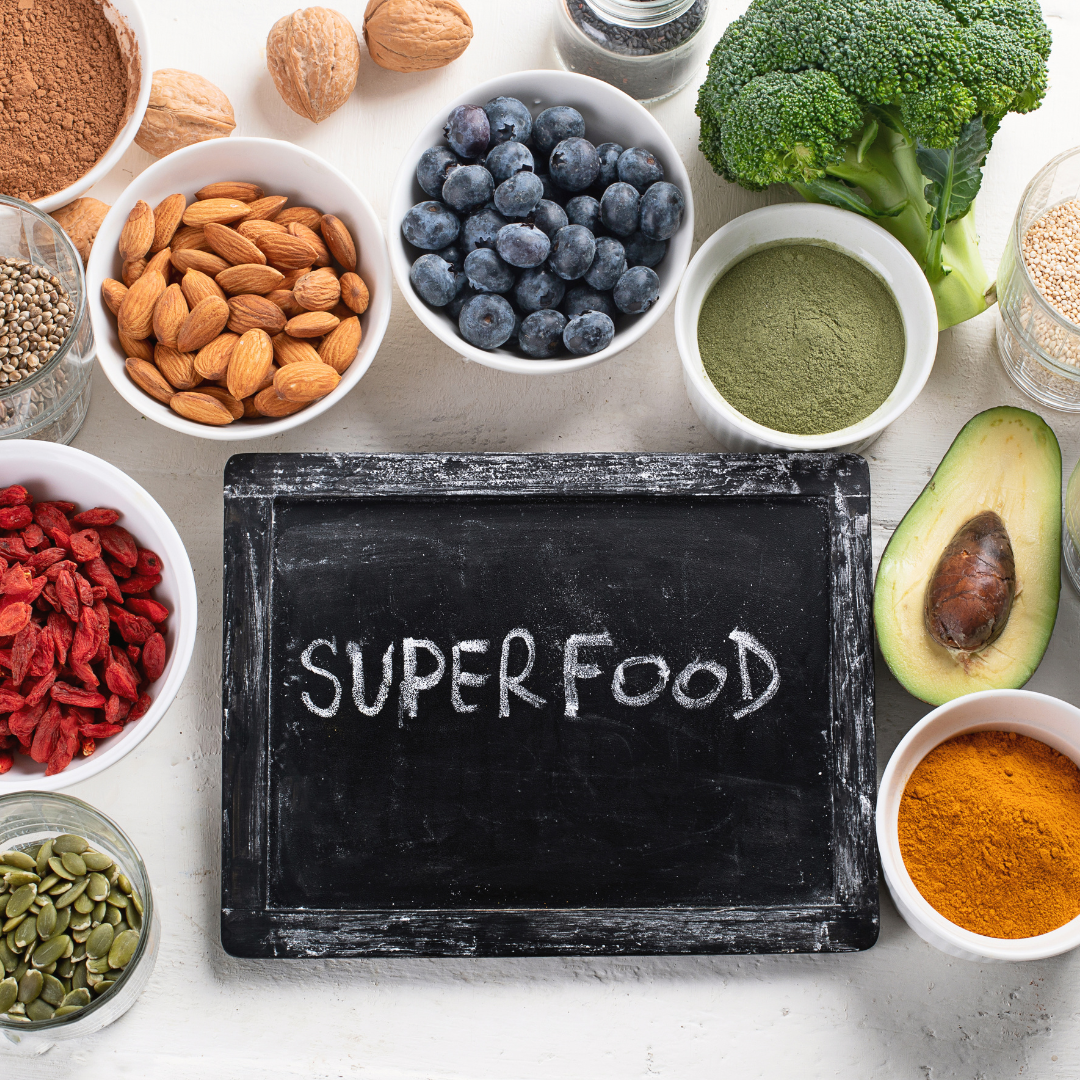Top Superfoods You Should Add To Your Diet For Best Health
I wish there was a pill I could take and be healthy! In the fast-paced world we live in, maintaining good health has become more crucial than ever. Who wants to be sick and die? The latter is inevitable, but since nutrition is responsible for most diseases, let’s eat healthy and try to stay healthy, strong and happy as long as possible!
Superfoods have gained immense popularity for their exceptional nutrient profiles and the positive impact they can have on our overall well-being. In this comprehensive exploration, I will share the health benefits of various superfoods. Here are the top REAL FOODS:
- Vitamin C and Immune Boosting Properties
One of the key players in the superfood lineup is vitamin C, a potent antioxidant known for its immune-boosting properties. Foods like citrus fruits, goji berries, and black pepper are rich sources of vitamin C. Regular consumption of these superfoods can help strengthen the immune system, ward off infections, and contribute to overall health. Here are the top 10:
- Acerola Cherries
- Guava
- Kiwi
- Strawberries
- Papaya
- Bell Peppers
- Oranges
- Pineapple
- Mango
- Broccoli
- Whole Grains for Sustained Energy
In the quest for sustained energy levels, whole grains emerge as nutritional powerhouses. Here are the best:
- Quinoa – complete protein, meaning it contains all nine essential amino acids. It is also rich in fiber, iron, and magnesium.
- Brown Rice – whole grain that retains the bran and germ layers, providing more fiber, vitamins, and minerals compared to white rice.
- Oats – good source of soluble fiber, particularly beta-glucans, which can help lower cholesterol levels. They are also rich in manganese, phosphorus, and magnesium.
- Barley – contains both soluble and insoluble fiber, along with vitamins and minerals. It has a nutty flavor and chewy texture, making it a versatile ingredient.
- Buckwheat – despite its name, buckwheat is not a true grain but a pseudocereal. It is gluten-free and rich in protein, fiber, and various antioxidants.
- Farro – ancient wheat variety that is rich in fiber, protein, and nutrients like magnesium and iron. It has a chewy texture and nutty flavor.
- Millet – gluten-free grain that is rich in magnesium, phosphorus, and antioxidants. It has a mild flavor and a versatile culinary profile.
- Whole Wheat – includes all three parts of the wheat kernel—the bran, germ, and endosperm—providing more fiber and nutrients than refined wheat products.
- Amaranth – gluten-free and rich in protein, fiber, and micronutrients like calcium and iron.
- Freekeh – ancient grain made from roasted green wheat. It is high in fiber, protein, and several vitamins and minerals.
3. Sweet Potatoes: A Nutrient-Dense Root Vegetable
Sweet potatoes are not only a delicious addition to meals but also a nutritional powerhouse. Packed with vitamins, minerals, and antioxidants, sweet potatoes offer numerous health benefits, from supporting bone health to boosting the immune system.
4. Chia Seeds
Chia seeds have gained popularity as a superfood for their rich content of essential amino acids, omega-3 fatty acids, and fiber.
5. Vitamin E
Vitamin E, a powerful antioxidant, plays a crucial role in maintaining eye health and preventing macular degeneration. Here is my favorite list of where to find it in nature:
- Nuts and Seeds
- Sunflower seeds
- Almonds
- Hazelnuts
- Pine nuts
- Walnuts
- Vegetable Oils
- Sunflower oil
- Wheat germ oil
- Olive oil
- Almond oil
- Leafy Greens
- Spinach
- Swiss chard
- Kale
- Turnip greens
- Collard greens
- Fruits
- Kiwi
- Avocado
- Blackberries
- Mango
- Fortified Foods
- Some plant-based foods are fortified with vitamin E, such as certain breakfast cereals, plant-based milk alternatives, and spreads.
6. Cruciferous Vegetables for Cancer Prevention
Cruciferous vegetables are highly nutritious and offer various health benefits. Rich in vitamins, minerals, and fiber, they contain antioxidants. Regular consumption of cruciferous vegetables is associated with improved cardiovascular health, digestive function, and overall well-being.
- Broccoli – everyone know this one!
- Cauliflower – used in various dishes and can be roasted, mashed, or used as a low-carb alternative to rice.
- Cabbage – comes in various forms, including green, red, and savoy. It is often used in salads, coleslaw, and stir-fries.
- Kale – leafy green with a slightly bitter taste. It is popular in salads, smoothies, and can be baked into kale chips. When massaged with lemon juice, salt and a little oil, the bitterness disappears!!
- Brussels Sprouts – small, green cruciferous vegetables that resemble miniature cabbages. They are often roasted or sautéed as a side dish or minced for salads.
- Bok Choy – or Chinese cabbage, has dark green leaves and white stalks. It is commonly used in Asian cuisine, both cooked and raw.
- Radishes – root vegetables that come in various colors and shapes. They add a peppery flavor to salads and other dishes.
- Turnips – root vegetables with a slightly peppery taste. Both the root and the green tops can be eaten.
- Arugula – also known as rocket, has a peppery flavor and is often used in salads and as a pizza topping.
- Mustard Greens – distinct peppery taste and are commonly used in salads, stir-fries, or sautéed as a side dish.
7. Legumes & Soy
In the pursuit of a plant-based protein source, legumes (lentils/beans) and soy products take the spotlight. Understand the importance of incorporating plant-based proteins into your diet, and explore the benefits for muscle health, weight management, and overall well-being. My favorite protein:
- Lentils – versatile legume rich in protein, fiber, and various nutrients. They come in different varieties, including green, brown, and red, and can be used in soups, stews, salads, and more.
- Chickpeas – also known as garbanzo beans, are a great source of protein and fiber. They can be used in a variety of dishes, including hummus, curries, and salads.
- Quinoa – complete protein, containing all essential amino acids. It is a grain-like seed that can be used as a base for salads, bowls, or as a side dish.
- Tofu – made from soybeans, is a versatile and protein-rich food. It can be used in both savory and sweet dishes, taking on the flavors of the ingredients it’s cooked with.
- Tempeh – fermented soybean product that is high in protein and has a nutty flavor. It can be grilled, sautéed, or crumbled into various dishes.
- Edamame – are young, green soybeans and are a delicious and protein-rich snack or addition to salads and stir-fries.
- Black Beans – good source of protein, fiber, and various vitamins and minerals. They can be used in a variety of dishes, such as soups, salads, and tacos.
- Chia Seeds – rich in protein but also high in omega-3 fatty acids, fiber, and antioxidants. They can be added to smoothies, yogurt, or used to make chia pudding.
- Hemp Seeds – complete protein and also provide healthy fats, including omega-3s. They can be sprinkled on salads, yogurt, or added to smoothies.
- Peas – including green peas and split peas, are good sources of plant-based protein. They can be used in soups, stews, or as a side dish.
8. Dark Chocolate
Yes, you read it right – dark chocolate is a superfood! Delve into the delightful world of dark chocolate and its health benefits, from improving heart health to enhancing mood. Learn how to choose the right type of dark chocolate and savor its goodness in moderation.
9. Fermented Foods
Maintaining a healthy gut is essential for overall well-being, and adding fermented superfoods into your diet can contribute to a happy and balanced digestive system.
- Sauerkraut – fermented cabbage that’s packed with probiotics. It has a tangy flavor and is often used as a condiment or side dish.
- Kimchi – traditional Korean dish made from fermented vegetables, usually napa cabbage and Korean radishes, seasoned with chili pepper, garlic, ginger, and other spices.
- Miso – a Japanese seasoning made by fermenting soybeans, barley, or rice with salt and koji (a type of fungus). It is commonly used to make miso soup and adds a rich umami flavor to dishes.
- Tempeh – fermented soybean product with a firm texture and nutty flavor. It’s a versatile protein source and can be used in various dishes, including stir-fries and sandwiches.
- Natto – traditional Japanese dish made from fermented soybeans. It has a unique sticky texture and is often served with rice.
- Fermented Pickles – traditional pickles that are naturally fermented (not pickled in vinegar) provide probiotics. Look for pickles in the refrigerated section of the grocery store.
- Coconut Yogurt – fermented coconut yogurt is a dairy-free alternative to traditional yogurt. It’s made by fermenting coconut milk with probiotic cultures.
- Fermented Salsa – salsa can be fermented to enhance its flavor and nutritional profile. Fermented salsa typically contains ingredients like tomatoes, onions, garlic, and peppers.
- Fermented Hot Sauce – some varieties of hot sauce are naturally fermented, providing not only heat but also probiotics.
Summary
Superfoods are loaded with antioxidants, vitamins, and minerals. While there’s no single “miracle” food, incorporating superfoods into your diet is one way to ensure that you are consuming important nutrients.

